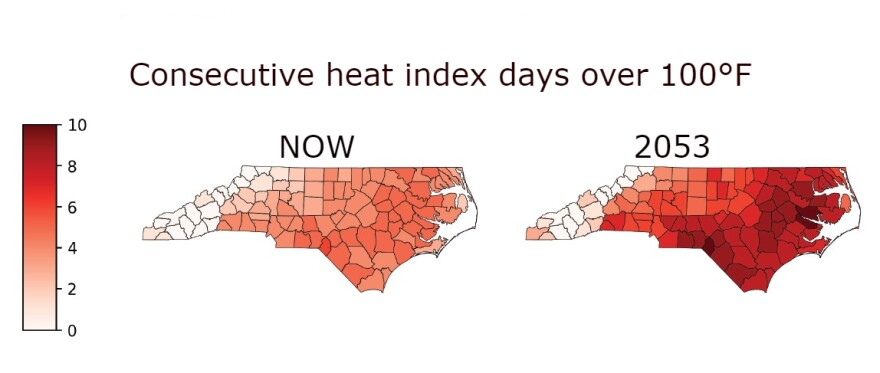As temperatures in Charlotte pushed above 90 degrees Fahrenheit again Monday, uptown's Roof Above's Day Services Center was a refuge for people experiencing homelessness. Fans and misting stations were on and the air-conditioned building was open to help people stay cool.
Officials at Roof Above say it's like this on days when temperatures rise. And the number of days is rising.
A new report says dangerously hot days will multiply across the U.S. over the next 30 years due to global warming, even in normally cooler areas like North Carolina's mountains.
The report, "Hazardous Heat," was published Aug. 15 by the First Street Foundation, a New York-based science and technology nonprofit that focuses on climate change. Researchers used federal and third-party climate data to study past summer heat trends and develop a model for future temperatures.
For example, in Charlotte and Raleigh, the hottest seven days now have a heat index, a "feels-like" temperature combining heat and humidity, of more than 104 degrees. That will increase to 17 days by 2053.
In Charleston, SC, the hottest seven days with a 105-degree heat index will nearly triple, said First Street's Jeremy Porter.
"The way to phrase it (is) your hottest week in Charleston is going to become about your hottest three weeks in Charleston, in 30 years," Porter said.
The report describes the emergence of an "Extreme Heat Belt" across the central United States where heat index values already sometimes top 125 degrees — a level that scientists and doctors say presents major health risks.

On the North Carolina coast, the seven hottest days in Carteret and Dare counties (at or above 103 and 102, respectively, this year) will triple to 21 days over the next 30 years, the report says.
About 8.1 million people in 50 U.S. counties will see heat index values above 125 degrees over the next year, according to the report. By 2053, that number will rise to 107.6 million Americans in more than 1,000 counties — or about one-quarter of the U.S.
Temperatures also will be hotter along the West and East coasts, though not to the same extremes as the central U.S., Porter said. With that said, there are also risks with big relative increases, he said.
For example, in North Carolina, higher elevations in mountain areas in the west and some areas along the Atlantic Ocean in the east mean that temperatures may not reach heat indexes of 100 degrees.
Still, even in these cooler areas, the hottest seven days will multiply, leading to the same kinds of health risks, Porter said.
In Ashe County, in North Carolina's mountains, the hottest seven days at 89 degrees will become 20 days in 30 years.
Watauga County, also in North Carolina's mountains, currently experiences a heat index of 88 degrees on its hottest seven days. By 2053, that number will rise to 20 days. Similar increases are expected for Haywood, Avery, Macon, Madison, Swain and Yancey counties.
The effect is even worse when those hot days occur in succession, known as "consecutive dangerous days," the report says.
Porter hopes local officials will use the data to improve their ability to respond to deadly extreme heat emergencies.
"There are large implications for state and local policy and community leaders in general," Porter said.
At the Roof Above Day Center, extreme heat days not only bring a flood of residents to cool off, but also strain other facilities, said Randall Hitt, Roof Above's vice president of engagement.
"Typically there are around 40 to 45 showers daily on weekdays, with about 20 to 25 on weekends, when we can offer. Laundry is nearly always full — 21 loads daily on weekdays and seven on weekends, when we’re able," he said.
Hitt said they've been going through 60 to 65 cases of bottled water every week. They've had to ask the community for donations to keep up with demand during the heat.
The demand will only increase as the number of extreme heat days do in the coming years.

A version of this story originally appeared in WFAE's weekly Climate newsletter, which is published Thursdays.







